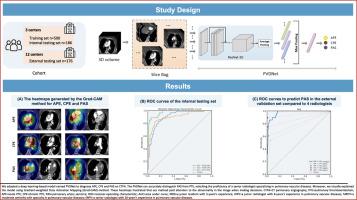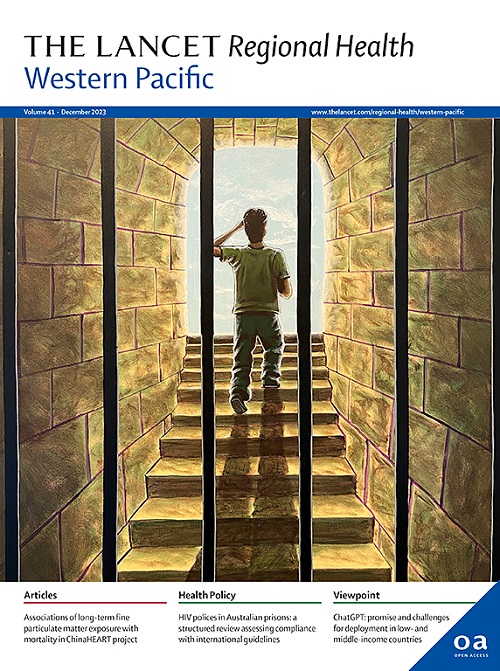开发一个基于深度学习的成像诊断框架,PVDNet,用于鉴别肺动脉肉瘤和肺血栓栓塞:一项多中心观察研究
IF 8.1
1区 医学
Q1 HEALTH CARE SCIENCES & SERVICES
引用次数: 0
摘要
基于CT肺血管造影(CTPA)鉴别肺动脉肉瘤(PAS)和肺血栓栓塞(PTE)是一个巨大的挑战,需要结合其他方法,如深度学习(DL)。本研究旨在开发和验证一个基于dl的模型PVDNet,用于区分PAS和PTE在CTPA上的差异。方法回顾性分析来自中国肺栓塞多模态成像人工智能(CHOICE)研究的CTPA图像数据集,建立并验证区分PAS和PTE的DL模型,包括来自15家医院的952例患者(470例急性PTE [APE], 363例慢性PTE [CPE]和119例PAS)的CTPA图像数据集。训练集包括来自590名患者的CTPA图像,内部测试集包括来自186名患者的CTPA图像,均来自相同的三个中心。来自12个中心的176例患者的CTPA图像用于外部验证。采用深度学习框架PVDNet进行细粒度分类。同时,外部验证集中的CTPA图像由四名不同专业水平的放射科医生独立评估。主要观察指标为曲线下面积(AUC)和一致性检验。在内部测试集中,PVDNet对PAS (95% CI:[0.945, 0.994])、APE (95% CI:[0.855, 0.944])和CPE (95% CI:[0.852, 0.946])的AUC分别为0.972、0.902和0.900。此外,PVDNet模型显示出PAS和PTE之间的有效区分,在外部验证集中显示出与专门研究肺血管疾病(SRPV)的高级放射科医生相当的AUC值(0.973对0.943,p = 0.308)。模型与SRPV有中等程度的一致性(kappa = 0.651, p <;0.001),这在四位读者中是最高的。pvdnet模型可以区分PAS和PTE,其性能接近专门从事肺血管疾病的高级放射科医生的熟练程度。PVDNet区分APE和CPE的性能需要进一步优化。国家自然科学基金项目(No. 82272081),中国医学科学院医药卫生科技创新专项(No. 2021-I2M-1-049),国家重点研发计划项目(No. 2023YFC2507200)。本文章由计算机程序翻译,如有差异,请以英文原文为准。

Developing a deep learning-based imaging diagnostic framework, PVDNet, for differentiating pulmonary artery sarcoma and pulmonary thromboembolism: a multi-center observational study
Background
Differentiating pulmonary artery sarcoma (PAS) from pulmonary thromboembolism (PTE) based on CT pulmonary angiography (CTPA) is a big challenge, necessitating the incorporation of other methods, such as deep learning (DL). This study aimed to develop and validate a DL-based model, PVDNet, for differentiating PAS and PTE on CTPA.
Methods
This study retrospectively analyzed CTPA image datasets from the prospective CHinese pulmOnary embolism multimodality Imaging artifiCial intelligencE (CHOICE) study to develop and validate a DL model for differentiating PAS from PTE. CTPA image datasets of 952 patients (470 acute PTE [APE], 363 chronic PTE [CPE], and 119 PAS) from 15 hospitals were included. The training set comprised CTPA images from 590 patients, and the internal test set comprised those from 186 patients, all obtained from the same three centers. CTPA images of 176 patients from 12 centers were used for external validation. A DL framework, PVDNet, was employed to perform fine-grained classification. Meanwhile, CTPA images in the external validation set were independently assessed by four radiologists with different levels of expertise. The main outcome measures were area under the curve (AUC) and the consistency test.
Findings
In the internal test set, PVDNet achieved an AUC of 0.972, 0.902, and 0.900 for PAS (95% CI: [0.945, 0.994]), APE (95% CI: [0.855, 0.944]), and CPE (95% CI: [0.852, 0.946]), respectively. Furthermore, PVDNet model demonstrated effective differentiation between PAS and PTE, showing comparable AUC values to a senior radiologist specialized in pulmonary vascular diseases (SRPV) in the external validation set (0.973 vs. 0.943, p = 0.308). The model achieved moderate agreement with SRPV (kappa = 0.651, p < 0.001), which was the highest among four readers.
Interpretation
PVDNet model could differentiate PAS from PTE, with performance approaching the proficiency level of a senior radiologist specializing in pulmonary vascular diseases. PVDNet's performance in distinguishing APE from CPE requires further optimization.
Funding
National Natural Science Foundation of China (No. 82272081), Medical and Health Science and Technology Innovation Project of Chinese Academy of Medical Science (No. 2021-I2M-1-049), and the National Key Research and Development Program of China (No. 2023YFC2507200).
求助全文
通过发布文献求助,成功后即可免费获取论文全文。
去求助
来源期刊

The Lancet Regional Health: Western Pacific
Medicine-Pediatrics, Perinatology and Child Health
CiteScore
8.80
自引率
2.80%
发文量
305
审稿时长
11 weeks
期刊介绍:
The Lancet Regional Health – Western Pacific, a gold open access journal, is an integral part of The Lancet's global initiative advocating for healthcare quality and access worldwide. It aims to advance clinical practice and health policy in the Western Pacific region, contributing to enhanced health outcomes. The journal publishes high-quality original research shedding light on clinical practice and health policy in the region. It also includes reviews, commentaries, and opinion pieces covering diverse regional health topics, such as infectious diseases, non-communicable diseases, child and adolescent health, maternal and reproductive health, aging health, mental health, the health workforce and systems, and health policy.
 求助内容:
求助内容: 应助结果提醒方式:
应助结果提醒方式:


